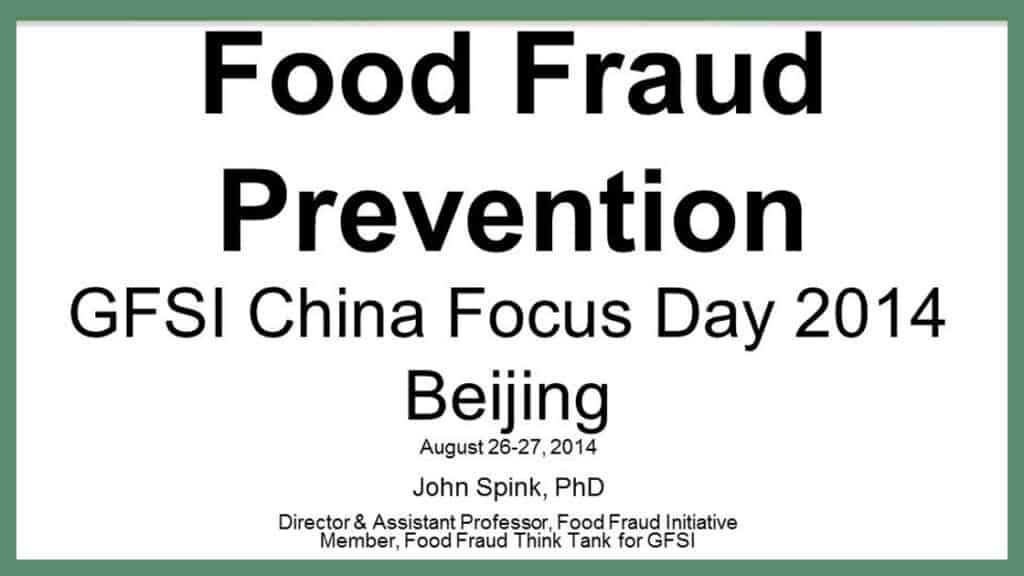This is an advance copy of my Food Fraud Overview presentation at the Global Food Safety Initiative (GFSI) China Focus Day, Beijing which is being held August 26-27, 2014. This includes our latest research on how incident clustering fits into the evaluation of the fraud opportunity, which is the theoretical foundation for a Food Fraud Vulnerability Assessment. Earlier in the week on Monday, August 25 I am presenting similar content at the Annual Meeting of the Korean Society for Food Science and Technology in Seoul.
To review some of the content, we will address the consistent themes as well as present a few new insights:
- Consistent Themes
- Create and Engage a Public-Private Partnership: Food Fraud prevention is a very complex concept that can really only be addressed efficiently through collaboration.
- Focus on Prevention not just Detection: Every research, government, or industry effort should start with a focus on prevention. Our goal is not to detect adulterants but to prevent them from getting in the food in the first place! Detection is critical – if we can’t find the adulterant then we can’t prevent it – but every effort should be clearly defined on how it specifically contributes to prevention. It is not just enough to say “better detection will help prevent Food Fraud.” (We will be addressing this in a future blog post and a working paper.)
- Emphasize Understanding the Motivation to Disrupt the Act: For Food Fraud the “organism” is a human not a microbe. The field of science that addresses microbes is microbiology; the field of science that addresses humans is the behavioral sciences and criminology. Also, within microbiology, there are separate lanes for different microbes such as Salmonella and Listeria. The same is true for Food Fraud, where it is very different to combat date code tampering or adulteration.
- New Insights
- Using the term Adulterant vs. Adulteration: There is often confusion around the use of these terms. The US FDA’s Food Drug and Cosmetics Act defined “adulterated foods.” A food could be defined as “adulterated” if is spoiled or if it is stolen goods. So, technically, a food could be “adulterated” without an “adulterant.” Where does “adulteration” fit in there? The FDA definition of “Economically Motivated Adulteration” specifies an “adulterant” – actually they use the term “substance.” Confused yet? Thus, our presentation shifted to only using the word “adulterant” and to avoid “adulterated” or “adulteration.” Using the Food Fraud term for the overall concept avoids this confusion.
- Foundation for Food Fraud Vulnerability Assessment – Incident Clustering and the Crime Triangle: There is quite a lot of activity and interest in developing standardized fraud-related vulnerability assessments. Our presentation consolidates three separate concepts into one continuum.
- The first step is to analyze and organize known incidents. These can be organized in the Product Counterfeit Incident Clustering Tool (Crime Science, January 2014 – Note: this included and was codified in ISO 12931/ ISO 22380 Product Authentication). This tool includes identifying the types of counterfeiting, types of counterfeiters, and offender organizations. For additional case studies we have an article on the Challenges of Intellectual Property Rights Enforcement in Ag and Food (Journal of Intellectual Property Rights, ). For incident data sets see the USP Food Fraud Database (Journal of Food Science 2012) and the NCFPD EMA Database (Journal of Food Protection, 2013).
- This analysis feeds into the Crime Triangle, which is used to deconstruct and understand the fraud opportunity (Journal of Food Science, 2011).
- Finally, this is core theory for assessing the vulnerabilities from the different types of acts such as adulteration, theft, tampering, over-runs, diversion, simulations, and counterfeiting (addressed in those previous articles). It would seem logical that there were separate assessments for the different types of Food Fraud. That said, they all need to integrate into one assessment.
With the Food Fraud prevention research evolving and transforming very quickly, attending events like this is critical to maintain our insight on the latest trends. When we attend and present we get a chance to share our latest theories and to discuss the application with practitioners. We are grateful for groups such as the GFSI and the Korean Society for Food Science and Technology. One of our “Call to Action” points for industry is to “Discuss the topic with governments and non-governmental organizations.” You can do this by attending conferences like these and then contributing to the discussion. Take part, speak up and help lead the direction of our food industry.
This was previously posted at: http://foodfraud.msu.edu/2014/08/24/presentation-food-fraud-vulnerability-assessment-foundation-at-the-gfsi-china-focus-day-beijing-korean-society-for-food-science-and-technology-gwangju-korea/

